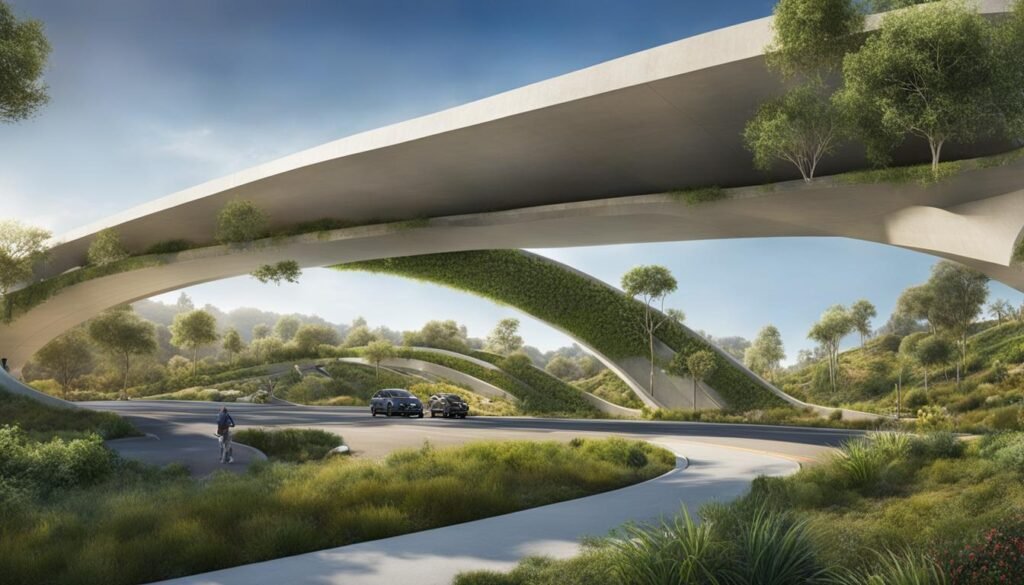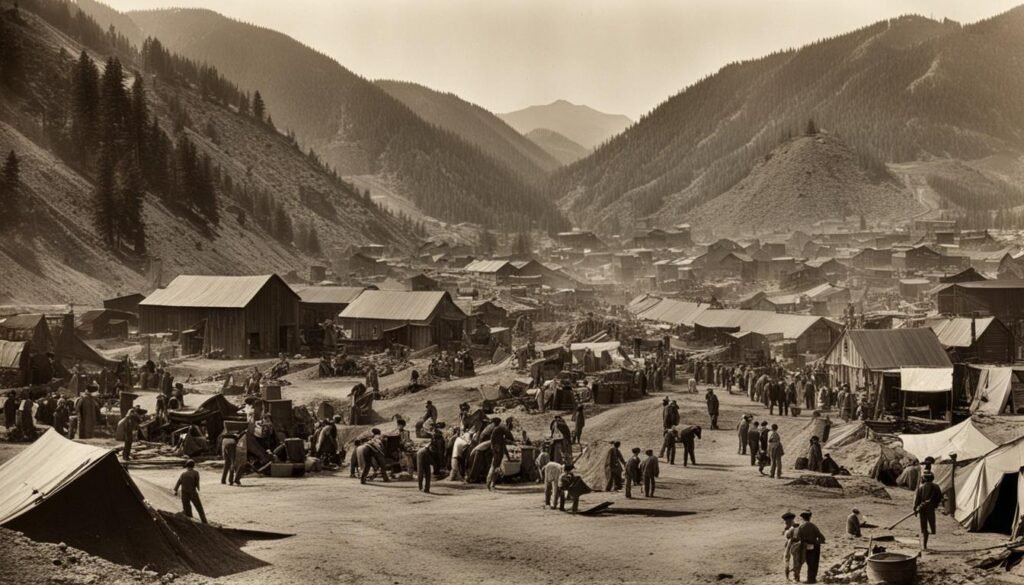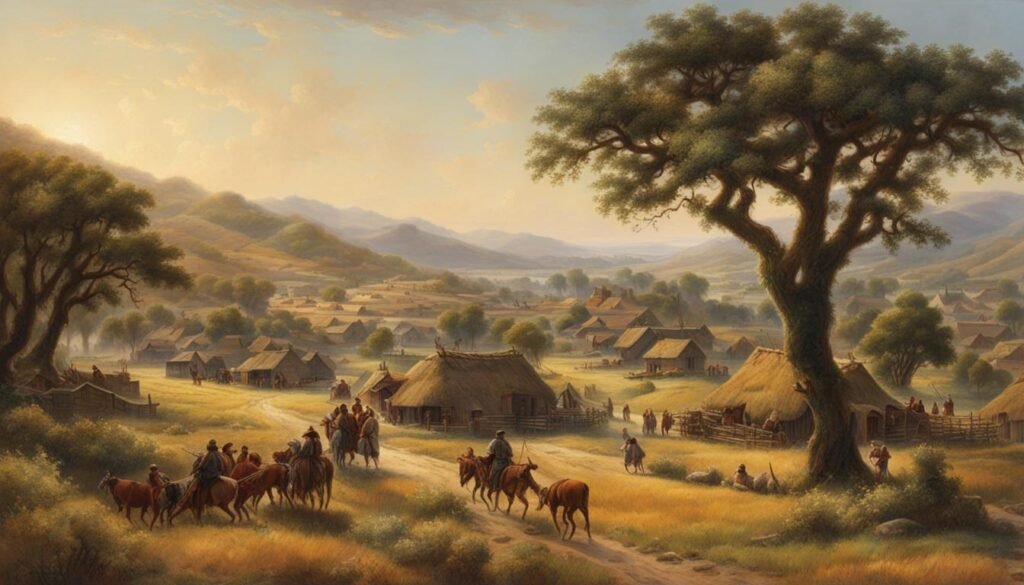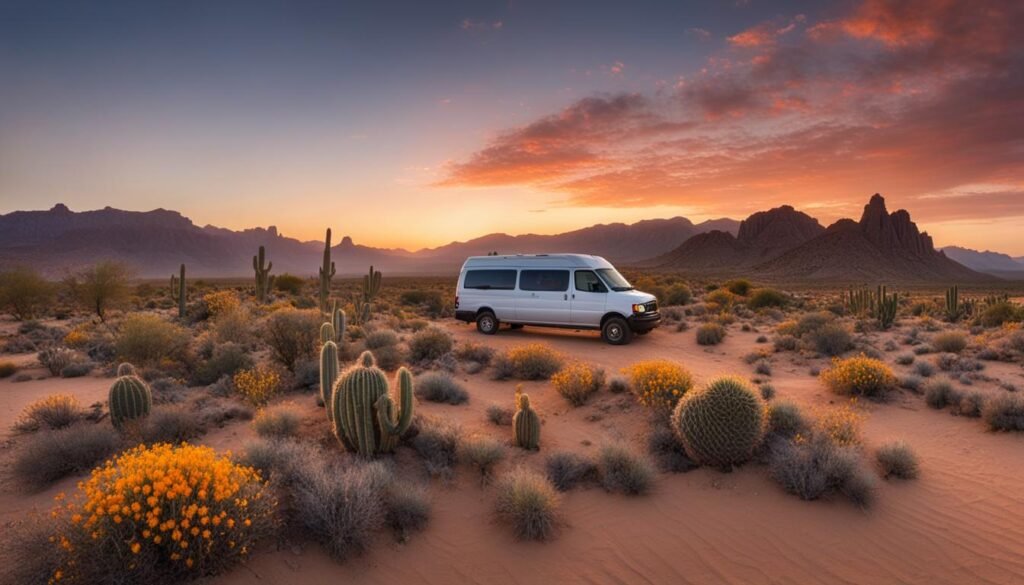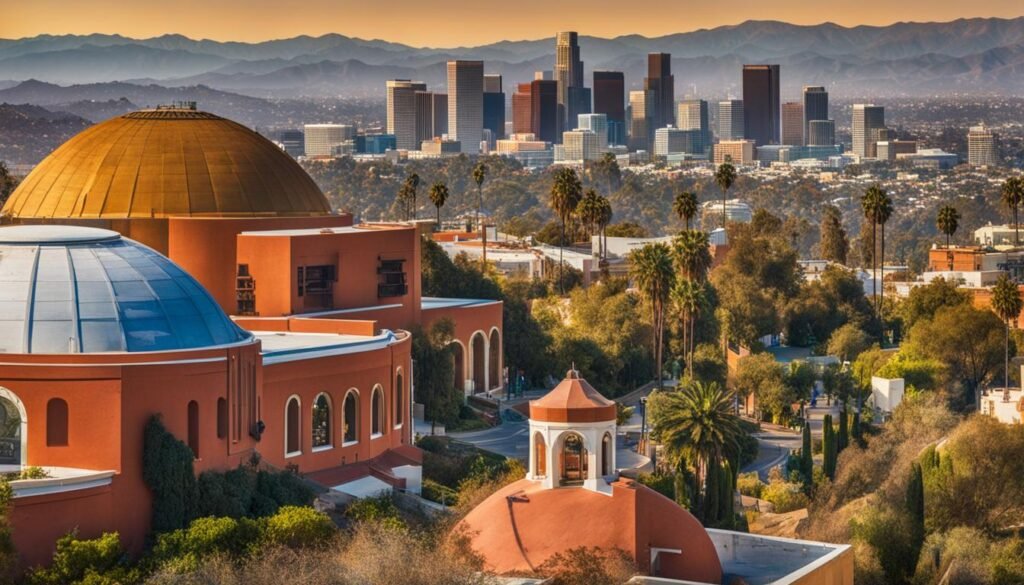Welcome to my article on the Wallis Annenberg Wildlife Crossing, a groundbreaking project that combines eco-innovation, wildlife conservation, and public-private partnerships. This monumental crossing, currently under construction, will play a crucial role in protecting and restoring wildlife habitats in Southern California.
Designed to span the 101 freeway in Agoura Hills, the Wallis Annenberg Wildlife Crossing will provide a safe passage for wildlife to navigate between different habitats. This ambitious endeavor has received significant support, including a generous $1 million challenge grant from Wallis Annenberg and the Annenberg Foundation, accelerating the construction timeline and ensuring the realization of this impactful project.
Once completed in 2025, the Wallis Annenberg Wildlife Crossing will be the largest wildlife corridor in the world, revolutionizing wildlife connectivity in the region. It will allow numerous species to cross the freeway without the risk of death or accidents, safeguarding their survival and promoting biodiversity.
Key Takeaways:
- The Wallis Annenberg Wildlife Crossing aims to protect and restore wildlife habitats in Southern California.
- It is currently under construction and expected to be completed in 2025.
- The crossing will provide a safe passage for wildlife to navigate across the 101 freeway in Agoura Hills.
- Significant donations, including a $1 million challenge grant from Wallis Annenberg, have helped fund the project.
- Once completed, it will be the largest wildlife corridor in the world, ensuring the survival of many isolated species.
The Importance of the Wallis Annenberg Wildlife Crossing
The Wallis Annenberg Wildlife Crossing plays a crucial role in preserving wildlife habitats and biodiversity in Southern California. This innovative project aims to restore fragmented ecosystems caused by human development and provide a safe passage for wildlife to cross the busy 101 freeway. By connecting fragmented habitats and facilitating natural animal migration, the crossing helps ensure the continuation of genetic diversity and the preservation of the diverse wildlife population in the Santa Monica Mountains region.
The Santa Monica Mountains are home to numerous species, including mountain lions, bobcats, bats, and desert cottontails. The Wallis Annenberg Wildlife Crossing offers these animals and other wildlife the opportunity to move freely between habitats, enhancing wildlife habitat connectivity and supporting overall ecological health. This connectivity is crucial for the long-term survival of these species and contributes to urban wildlife conservation efforts.
Moreover, the wildlife crossing serves as a crucial component for freeway wildlife connectivity, mitigating the negative environmental impacts of the freeway on wildlife populations. By providing a safe crossing path over the freeway, the project reduces wildlife-vehicle collisions and the associated risks to both motorists and animals.
The Wallis Annenberg Wildlife Crossing also plays a significant role in environmental impact mitigation. It helps minimize habitat fragmentation, promotes the restoration of degraded habitats, and fosters the creation of a continuous wildlife corridor. By restoring ecological connectivity, the crossing allows for the free movement of wildlife, enabling essential activities such as foraging, breeding, and dispersal.
To fully appreciate the importance of this wildlife bridge, one must understand the critical role it plays in supporting animal migration. The crossing allows animals to navigate obstacles that would otherwise hinder their natural movement patterns. This is particularly vital for species that require large home ranges and have specific habitat requirements.
The Wallis Annenberg Wildlife Crossing is a shining example of environmental stewardship and serves as a testament to the commitment of all those involved in its design, construction, and support. By combining sophisticated engineering with ecological restoration principles, the crossing demonstrates how wildlife habitat connectivity can be achieved in urban areas, setting a precedent for future conservation projects.

This image illustrates the integral role of the Wallis Annenberg Wildlife Crossing in facilitating safe wildlife passage across the 101 freeway, connecting vital habitats and ensuring the preservation of biodiversity.
The Design and Construction of the Wallis Annenberg Wildlife Crossing
The design and construction of the Wallis Annenberg Wildlife Crossing require meticulous planning and expertise. This remarkable project will span over ten lanes of the U.S. 101 freeway in the Agoura Hills area near Los Angeles, creating a monumental structure that incorporates robust engineering and ecological restoration plans.
The crossing will provide a safe passage for wildlife and will be covered with nearly one acre of new native wildlife habitat. This carefully designed habitat will promote the growth of vegetation and create a suitable environment for wildlife to thrive in. The crossing aims to enhance wildlife connectivity by allowing animals to navigate freely without the risks posed by busy freeways.
To ensure the success of the crossing’s design, the project has engaged experienced landscape architects and experts in biology, horticulture, soil science, and mycology. With their combined knowledge, they are working to establish a wildlife crossing that seamlessly integrates with the surrounding ecosystem.
Construction of the Wallis Annenberg Wildlife Crossing is currently underway and is expected to be completed by 2025. This ambitious endeavor represents a significant step forward in wildlife conservation and will pave the way for similar projects in the future.

Recognition and Impact of the Wallis Annenberg Wildlife Crossing
The Wallis Annenberg Wildlife Crossing has received widespread recognition for its innovative design and significant impact on wildlife conservation in Los Angeles. The project has garnered attention and admiration from various organizations and experts in the field.
One notable achievement is the crossing’s inclusion in the prestigious list of the most influential projects of 2022 by the Project Management Institute. This recognition places the Wallis Annenberg Wildlife Crossing in the same league as groundbreaking endeavors like the Webb Space Telescope and the Human Genome Project.
The crossing’s impact extends beyond its recognition as an influential project. It has been acknowledged for its valuable contribution to wildlife conservation and the restoration of ecosystems in the region. By providing a safe passage for wildlife, the crossing facilitates the movement of animals between disjointed habitats, supporting the preservation of biodiversity and genetic diversity.
The Wallis Annenberg Wildlife Crossing sets a remarkable example for future wildlife bridge projects around the world. Its innovative design and effective implementation serve as a blueprint for creating wildlife corridors that enable safe animal migration and protect vulnerable species.
The recognition and success of the Wallis Annenberg Wildlife Crossing are the result of the generous support and funding from Wallis Annenberg, the Annenberg Foundation, and numerous philanthropic and corporate institutions. Their contributions have made it possible to realize the vision of a wildlife bridge that will have a lasting impact on the conservation of wildlife and the preservation of ecosystems for generations to come.
Conclusion
The Wallis Annenberg Wildlife Crossing stands as a remarkable testament to the potential of public-private partnerships in safeguarding and reviving wildlife habitats. Its construction and design embody a steadfast commitment to environmental sustainability and the preservation of biodiversity. As the largest wildlife corridor worldwide, this project sets a precedent for future wildlife bridges and connectivity initiatives, ensuring the protected and unobstructed passage of wildlife across bustling freeways and enabling the survival of isolated species.
Upon completion, the Wallis Annenberg Wildlife Crossing will represent a momentous milestone in wildlife conservation, leaving an enduring legacy for the thriving urban wildlife of Los Angeles. With the implementation of this visionary endeavor, wildlife populations will regain connectivity and fragmented ecosystems will be restored to their natural state. The crossing serves as a vital model for promoting wildlife habitat corridors and mitigating the detrimental impact of human development on animal migration.
By embracing the Wallis Annenberg Wildlife Crossing, we actively contribute to the preservation of our planet’s irreplaceable wildlife resources. This groundbreaking project signifies a triumph in urban wildlife conservation, demonstrating the significant impact that can be achieved when communities, organizations, and individuals unite to protect and restore the delicate balance of our ecosystems. Together, we can foster a harmonious coexistence with wildlife, fostering a sustainable future for generations to come.
FAQ
What is the Wallis Annenberg Wildlife Crossing?
The Wallis Annenberg Wildlife Crossing is a monumental public-private partnership that aims to protect and restore wildlife habitats in Southern California. It is a wildlife bridge being built across the 101 freeway in Agoura Hills to provide a safe passage for wildlife to cross into different habitats.
When is the Wallis Annenberg Wildlife Crossing expected to be completed?
The Wallis Annenberg Wildlife Crossing is currently under construction and is expected to be completed in 2025.
Who has contributed to the funding and construction of the Wallis Annenberg Wildlife Crossing?
The project has received significant donations, including a $1 million challenge grant from Wallis Annenberg and the Annenberg Foundation, which helped raise funds and accelerate the construction timeline.
Once completed, how big will the Wallis Annenberg Wildlife Crossing be?
Once completed, the Wallis Annenberg Wildlife Crossing will be the largest wildlife corridor in the world.
Why is the Wallis Annenberg Wildlife Crossing significant for wildlife and the environment?
The Wallis Annenberg Wildlife Crossing will restore degraded habitats and fragmented ecosystems caused by human development. It will provide safe passage for wildlife to cross the 101 freeway, connecting fragmented habitats and allowing for natural animal migration. This will help maintain genetic diversity and preserve the biodiversity of the Santa Monica Mountains.
How is the design and construction of the Wallis Annenberg Wildlife Crossing being approached?
The Wallis Annenberg Wildlife Crossing will span over ten lanes of the U.S. 101 freeway in the Agoura Hills area near Los Angeles. It will incorporate robust engineering and ecological restoration plans and will be covered with nearly one acre of new native wildlife habitat. The project has engaged landscape architects and experts in various fields to ensure its success.
Has the Wallis Annenberg Wildlife Crossing received any recognition or awards?
Yes, the crossing was named one of the most influential projects of 2022 by the Project Management Institute. It has been acknowledged for its contribution to wildlife conservation, ecosystem restoration, and its potential as a model for future wildlife bridges.
How will the completion of the Wallis Annenberg Wildlife Crossing impact wildlife conservation?
The completion of the Wallis Annenberg Wildlife Crossing will mark a significant achievement in wildlife conservation. It will serve as a global model for urban wildlife conservation and will contribute to the protection of wildlife and ecosystems for generations to come.

